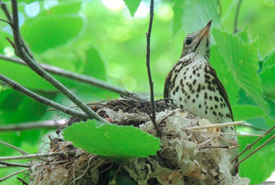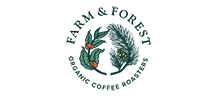
Adult wood thrush at her nest (Photo by Sue Hayes)
Wood thrush
During the spring and summer months, the wood thrush’s beautiful “eee-o-lay” call rings throughout deciduous forests in southeastern Canada. The wood thrush’s rusty-brown pattern means that you will likely hear it foraging for invertebrates on the ground long before you can see it in the leaf litter.
What does the wood thrush look like?
This medium-sized songbird is only slightly smaller than its close cousin, the American robin. Male and females look alike. They sport large brown spots on their cream-coloured breast and a white underbelly. Their underparts are russet brown.
Where does the wood thrush live?
In Canada, wood thrushes live in the mature deciduous and mixed-species forests of southern Ontario, Quebec, New Brunswick and Nova Scotia. In October, the birds migrate further south to Mexico and Central America to winter in warmer climates.
What is the wood thrush's conservation status?
Wood thrush has been assessed as threatened by the Committee on the Status of Endangered Wildlife in Canada. Since 2012, it has been protected under Canada’s Species at Risk Act.
The species is experiencing significant pressure from high rates of nest predation and cowbird parasitism. The forest habitat where they nest has been fragmented by deforestation. As a result, predators and parasites can access a higher proportion of wood thrush nests than usual.
What is NCC doing to help protect the wood thrush's habitat?
The Nature Conservancy of Canada (NCC) is working with researchers to investigate the pressures facing wood thrush populations. We are also looking at how best to improve habitat restoration and protection efforts for the species.
By securing large continuous areas of deciduous forest, such as Backus Woods in Ontario and the Northern Green Mountains in Quebec, NCC conserves important wood thrush habitat from further development and fragmentation. In Ontario’s Southern Norfolk Sand Plain Natural Area, NCC has restored former agricultural land around existing wood thrush habitat, increasing the amount of interior forest habitat.





